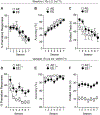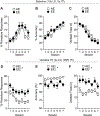Ethanol induces maladaptive impulse control and decreased seeking behaviors in mice
- PMID: 31012186
- PMCID: PMC6810713
- DOI: 10.1111/adb.12754
Ethanol induces maladaptive impulse control and decreased seeking behaviors in mice
Abstract
Waiting impulsivity is a risk factor for many psychiatric disorders including alcohol use disorder (AUD). Highly impulsive individuals are vulnerable to alcohol abuse. However, it is not well understood whether chronic alcohol use increases the propensity for impulsive behavior. Here, we establish a novel experimental paradigm demonstrating that continuous binge-like ethanol exposure progressively leads to maladaptive impulsive behavior. To test waiting impulsivity, we employed the 5-choice serial reaction time task (5-CSRTT) in C57BL/6J male mice. We assessed premature responses in the fixed and variable intertrial interval (ITI) 5-CSRTT sessions. We further characterized our ethanol-induced impulsive mice using Open Field, y-maze, two-bottle choice, and an action-outcome task. Our results indicate that continuous binge-like ethanol exposure significantly increased premature responses when mice were tested in variable ITI sessions even during a prolonged abstinent period. Ethanol-induced impulsive mice exhibited anxiety-like behavior during chronic exposures. This behavior was also observed in a separate cohort that was subjected to 20 days of abstinence. Ethanol-treated mice were less motivated for a sucrose reward compared with air-exposed control mice, while also demonstrating reduced responding during action-outcome testing. Overall, ethanol-treated mice demonstrated increased impulsive behavior, but a reduced motivation for a sucrose reward. Although waiting impulsivity has been hypothesized to be a trait or risk factor for AUD, our findings indicate that maladaptive impulse control can also be potentiated or induced by continuous chronic ethanol exposure in mice.
Keywords: AUD; alcohol; impulsivity; motivation; operant.
© 2019 Society for the Study of Addiction.
Conflict of interest statement
CONFLICT OF INTEREST
Dr. DS Choi is a scientific advisory board member to Peptron Inc. and the Peptron had no role in preparation, review, or approval of the manuscript; nor decision to submit the manuscript for publication. All the other authors declare no biomedical financial interests or potential conflicts of interest.
Figures




Similar articles
-
Repeated ethanol exposure during early and late adolescence: double dissociation of effects on waiting and choice impulsivity.Alcohol Clin Exp Res. 2014 Oct;38(10):2579-89. doi: 10.1111/acer.12535. Alcohol Clin Exp Res. 2014. PMID: 25346503
-
Influence of intertrial interval on basal and drug-induced impulsive action in the 5-choice serial reaction time task: Effects of d-amphetamine and (±)-2,5-dimethoxy-4-iodoamphetamine (DOI).Neurosci Lett. 2018 Jan 1;662:351-355. doi: 10.1016/j.neulet.2017.10.058. Epub 2017 Nov 2. Neurosci Lett. 2018. PMID: 29102783
-
The monoamine stabilizer (-)-OSU6162 prevents the alcohol deprivation effect and improves motor impulsive behavior in rats.Addict Biol. 2019 May;24(3):471-484. doi: 10.1111/adb.12613. Epub 2018 Feb 26. Addict Biol. 2019. PMID: 29480646 Free PMC article.
-
Alcohol outcomes on anxiety, impulsivity and spatial memory: Possible Omega-3 amelioration effects.Prog Neuropsychopharmacol Biol Psychiatry. 2025 Mar 20;137:111281. doi: 10.1016/j.pnpbp.2025.111281. Epub 2025 Feb 2. Prog Neuropsychopharmacol Biol Psychiatry. 2025. PMID: 39904400 Review.
-
An overview of measuring impulsive behavior in mice.Curr Protoc Mouse Biol. 2014 Jun 16;4(2):35-45. doi: 10.1002/9780470942390.mo140015. Curr Protoc Mouse Biol. 2014. PMID: 25723917 Review.
Cited by
-
Absence of effects of intermittent access to alcohol on negative affective and anxiety-like behaviors in male and female C57BL/6J mice.Alcohol. 2020 Nov;88:91-99. doi: 10.1016/j.alcohol.2020.07.011. Epub 2020 Aug 7. Alcohol. 2020. PMID: 32777473 Free PMC article.
-
N6-substituated adenosine analog J4 attenuates anxiety-like behaviors in mice.Psychopharmacology (Berl). 2022 Mar;239(3):887-895. doi: 10.1007/s00213-022-06079-8. Epub 2022 Jan 31. Psychopharmacology (Berl). 2022. PMID: 35102423 Free PMC article.
-
Sex differences in binge alcohol drinking and the behavioral consequences of protracted abstinence in C57BL/6J mice.Biol Sex Differ. 2023 Nov 13;14(1):83. doi: 10.1186/s13293-023-00565-0. Biol Sex Differ. 2023. PMID: 37957762 Free PMC article.
-
Engagement for alcohol escalates in the 5-choice serial reaction time task after intermittent access.Alcohol. 2024 Mar;115:79-92. doi: 10.1016/j.alcohol.2024.01.004. Epub 2024 Jan 28. Alcohol. 2024. PMID: 38286210 Free PMC article.
-
Adaptation of the 5-choice serial reaction time task to measure engagement and motivation for alcohol in mice.Front Behav Neurosci. 2022 Sep 16;16:968359. doi: 10.3389/fnbeh.2022.968359. eCollection 2022. Front Behav Neurosci. 2022. PMID: 36187376 Free PMC article.
References
-
- Association AP (ed). (2013) Diagnostic and Statistical Manual of Mental Disorders: Arlington, VA.
-
- Azorin JM, Belzeaux R, Kaladjian A, Adida M, Hantouche E, Lancrenon S, Fakra E (2013) Risks associated with gender differences in bipolar I disorder. J Affect Disord 151:1033–1040. - PubMed
-
- Bari A, Dalley JW, Robbins TW (2008) The application of the 5-choice serial reaction time task for the assessment of visual attentional processes and impulse control in rats. Nat Protoc 3:759–767. - PubMed
-
- Bari A, Robbins TW (2013) Inhibition and impulsivity: behavioral and neural basis of response control. Prog Neurobiol 108:44–79. - PubMed
Publication types
MeSH terms
Substances
Grants and funding
LinkOut - more resources
Full Text Sources

